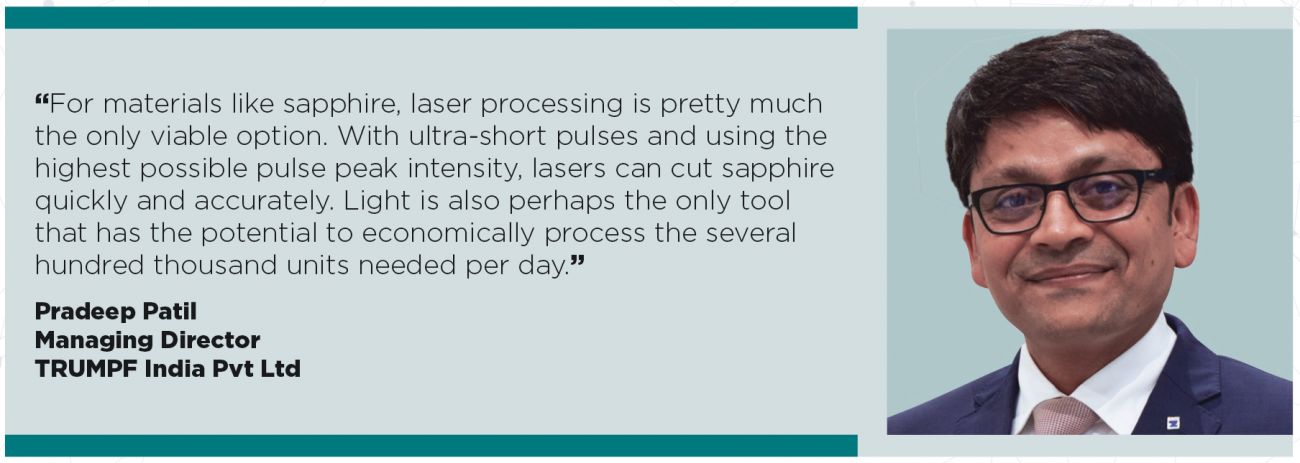HARNESSING LIGHT TO MANUFACTURE MOBILE DEVICES

Laser technology plays a pivotal role in the mobile device industry, being instrumental in manufacturing key components such as sapphire camera protection, polyimide flexible film circuits, and touchscreen display glass. Here’s more about it…
Smartphones, tablets, and phablets have made their way into every aspect of our lives and changed the way we work, bank, shop, learn, navigate, watch movies, or even take care of our health.
With technology advancing in leaps and bounds, any company wanting to take part in this industry requires two things: the ability to constantly bring out new features, and manufacturing processes that are ever more efficient and less expensive. These days lasers are already a key driver of innovation, for the latter in particular.
Camera protection on smartphones by using sapphire
Materials like sapphire, the second-hardest substance in the world, are ideal for use in devices that travel from hand to pocket several times a day, scraping against keys in the process. But the durability of sapphire is a double-edged sword as far as manufacturing is concerned.
Pradeep Patil, Managing Director, TRUMPF India Pvt Ltd, says, "For materials like sapphire, laser processing is pretty much the only viable option. With ultra-short pulses and using the highest possible pulse peak intensity, lasers can cut sapphire quickly and accurately. Light is also perhaps the only tool that has the potential to economically process the several hundred thousand units needed per day.”

Polyimide flexible film circuits
With mobile devices being packed with more features and sub-assemblies, there is increasingly less space inside the mobile phone.
A Sateesh Kumar, Managing Director, Meera Laser Solutions Pvt Ltd, one of India’s leading Laser integrators says, “One of the ways manufacturers are able to utilize space effectively is by using flexible film circuits made of polyimide, which can be shaped to space available inside the mobile device as these flexible polyimide films can be cut to the exact size and shape required. Lasers are perfect for this task, as they permit free forms, they do not suffer wear and tear, and exert no mechanical strain on the workpiece.”
|
Cutting by ultra pulsed lasers creates an intrinsic tension that causes the glass to break cleanly and exactly, to within a hundredth of a millimeter, along this fault line. The first machines able to cut glass in this way have already been built. |
Lasers for machining touch screen display glass
The touch screen is by far the most expensive component on a mobile device. The display assembly alone accounts for about a quarter of total production costs, making it the best area to look for cost savings.
Patil says, “A display is made up of two glass sheets, each around 300 micrometers thick. Between them lie the transistors for controlling the pixels, the liquid crystals in the LCDs or the OLEDs, and one or two coated films for the touch screen functions. The glass used is constantly being made thinner and tougher, which makes it even harder to process. It’s almost impossible to cleanly score and break this new glass. Etching is one viable alternative, but dry processes using lasers are always going to be easier and less troublesome. Ultra-short pulse lasers cut the glass in a cold process that does not cause thermal or mechanical stresses in the workpiece. As a bonus, the lasers produce smooth edges that have no micro-fissures and require
no reworking.”

Ultra-short pulsed lasers for material modification inside the screen glass
A new technology that we could see emerging in the near future is ultra-short pulsed lasers to modify extremely narrow areas inside the glass along the ‘cutting’ line. Cutting by ultra pulsed lasers creates an intrinsic tension that causes the glass to break cleanly and exactly, to within a hundredth of a millimeter, along this fault line. The first machines able to cut glass in this way have already been built.
Patil says, “Not only does this new cutting technique give manufacturers the opportunity to dispense with expensive intermediate steps in today’s industrial display screen manufacturing processes. It also allows the process to be reorganized. Because the laser cuts hardened glass quickly and without touch-up work, the future could see processing steps such as hardening, coating, and structuring being carried out at a greater scale on large panels. Lasers could then cut the large panel into smaller sections at the very end of the process.”
Using lasers for flexible screens with OLED
Lasers are also the way forward for the screens of the future. Flexible OLED screens are a dream come true for product designers and production engineers.
Sateesh says, “Flexible displays would make roll-to-roll manufacturing techniques a real possibility. They would simply be wound off and on, passing through various printing and coating machines as part of continuous processes before being cut into displays of all sizes by a laser beam in a final step.”
Lasers are also currently being used for a host of applications for the mobile devices industry like marking QR codes and serial numbers on components, logos on smartphone cases, battery welding, etc. With mobile phone and mobile network technology exploding exponentially it is not going to be possible to make the devices of the future using technology from the past. The power of light is driving the production of mobile devices into the future.
Tech Talks is a column by industry veteran and journalist Reji Varghese that talks about the latest advancements in Machine Tools, provides snippets from history, interesting facts, etc. about the Machine Tool industry.
 |
Reji Varghese MD RV Forms & Gears |




 Facebook
Facebook.png) Twitter
Twitter Linkedin
Linkedin Subscribe
Subscribe